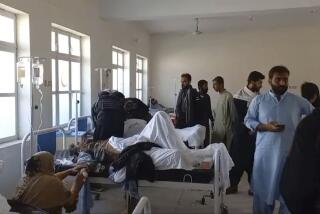Anti-Taliban Leader Believed Safe After Attack
- Share via
ISLAMABAD, Pakistan — A key anti-Taliban commander remained in Afghanistan on Friday after surviving a firefight with Taliban soldiers, and relatives said he had moved high into the mountains to avoid capture.
Hamid Karzai reportedly entered the country two weeks ago to organize resistance to the fundamentalist rulers of Afghanistan. He was apparently accompanied by a number of heavily armed men, which may have spared him the fate met by another anti-Taliban commander, Abdul Haq, who was captured and killed during a similar mission last week.
Meanwhile, there were unconfirmed reports from Afghan fighters based in Pakistan that a third anti-Taliban uprising was beginning in southern Afghanistan.
Any success in rallying opposition to the Taliban in its southern stronghold would be strategically significant for the U.S.-led military campaign in the country. It could also have a ripple effect in neighboring Pakistan, where citizens are increasingly pressing for an end to the war.
The intensity of public feeling prompted Pakistani President Pervez Musharraf on Thursday to institute measures to stifle public criticism. However, the new rules seemed to have little effect at weekly anti-government rallies Friday.
After Thursday’s gun battle, Karzai was reported to be in good condition.
Younger brother Ahmed Wali said he had spoken to Karzai about noon Friday by satellite phone. “They were having some kind of meeting with tribal leaders about the loya jirga when they were attacked by Taliban. There was some fighting and they were able to leave that area,” he said.
The loya jirga is the traditional Afghan convocation of tribes used to choose a new leader. It is expected that if the Taliban fell, there would be a loya jirga to allow representatives of all the groups in Afghanistan to decide who should lead them.
The Rome-based secretary to exiled Afghan king Mohammad Zaher Shah also said he spoke with Karzai on Friday. “He was in good shape,” Zalmai Rassoul said. His men “are safe, and they are inside Afghanistan.”
Karzai’s brief phone calls are a measure of the harshness of the terrain in which he is traveling, said an associate, Abdul Malik. Without a reliable source of electricity, Karzai would normally charge his satellite phone using a car battery. But not even a four-wheel-drive vehicle could traverse such difficult terrain, so he is traveling on foot, Malik said.
Other than the fact that Karzai is alive, which the Taliban and his family agree on, there is largely conflicting information about his situation.
Indeed, different Taliban spokesmen have different stories. The Taliban minister of information, Qari Fasil Rabi, was quoted as saying that two of Karzai’s men were killed in the fighting. But the corps commander of the southern town of Kandahar, Mulla Akhtar Usmani, reported that four of Karzai’s supporters were killed and 30 taken hostage.
Rassoul, secretary to the exiled king, reported that Karzai’s men suffered one death and one injury and took four Taliban soldiers prisoner.
Karzai’s family insists that none of his supporters were killed or taken captive.
There are also varying reports of how many men Karzai had with him. A local newspaper reporter was told 100, but another anti-Taliban commander said it could be as many as 700.
It appears that Karzai is better protected than was Haq, the commander killed last week. But Usmani warned, “If we arrest him, we will give him the same treatment that we gave Abdul Haq.”
Earlier reports that U.S. helicopters had rushed in to try to rescue Karzai were dismissed by his brother as “Taliban propaganda.”
Pakistan Protests Are Largely Peaceful
With great uncertainty about what is going on in Afghanistan, Pakistanis continued to air their antiwar sentiments Friday in rallies that tested the new laws put into effect by Musharraf.
But the protests were largely peaceful, and the wide government latitude to curtail them seemed almost unnecessary.
The laws ban inflammatory speeches against the government, processions and the use of loudspeakers except during Friday sermons. Anti-government marches in which effigies of President Bush and Musharraf are burned have become a weekly event in most large towns, and little seemed to have changed with the new rules.
In Marsden, a town near Islamabad, a large demonstration had an almost sleepy quality. At times the men on the scene were lulled into silence so perfect that the tinkle of bicycle bells could be heard from blocks away. No arrests were reported there or at smaller demonstrations in cities around the country, including Karachi, Lahore and Quetta.
But despite the relative tranquillity of the protests Friday, anger against Musharraf, who has opened Pakistani airspace to U.S. warplanes, was tangible.
“We can’t tolerate Musharraf anymore,” Islamic cleric Qasi Hussein Ahmad told the Marsden crowd. “The government is cooperating with America to earn dollars.”
And on the fringes of the crowd, police officials debated the new laws. Are all political speeches banned, or just threatening ones? Are peaceful demonstrations still allowed? And how, in a land where politics and religion are braided, does one differentiate between the two?
“I will struggle for jihad [holy war] in Afghanistan,” said a 20-year-old student named Qiam Maed, trotting alongside his friends after the demonstration. “And we will come up against Musharraf. We will finish his rule.”
*
Rubin reported from Quetta, Pakistan, and Stack from Islamabad. Times staff writer Richard Boudreaux in Rome contributed to this report.
More to Read
Sign up for Essential California
The most important California stories and recommendations in your inbox every morning.
You may occasionally receive promotional content from the Los Angeles Times.













